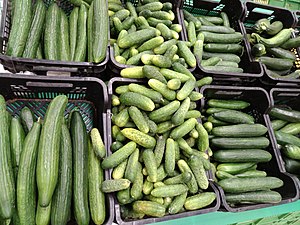Cookbook:Cucumber
| Cucumber | |
|---|---|
 | |
| Category | Vegetables |
Cookbook | Recipes | Ingredients | Vegetables
The cucumber, also known as a cuke, is a green vegetable related to the squash and melon.[1]
Characteristics[edit | edit source]
For the most part, cucumbers are elongated, with a nubby green skin and very pale green/white flesh.[2][1] The flesh is watery and crisp,[2][3] much like that of a melon, and most varieties have a seedy pulp running down the center of the cucumber. Older cultivars were moderately bitter, though modern varieties tend to be less so. However, environmental stressors can still cause even modern cucumbers to be bitter.[4] Some cucumbers, especially those with thin skins intended for raw consumption, may be coated with edible wax to reduce moisture loss.[4][5]
Generally, cucumbers are divided into "slicing" versus pickling varieties—the former can be eaten raw, while the latter are typically only pickled.[1][2][5]
The following are common varieties:
- Garden: dark green; large seeds; skin can be bitter[6]
- English/European/hothouse/seedless: long and thin; thin skin and minimal seeds; low bitterness; often wrapped in plastic[6][4]
- Persian: small and smooth; thin-skinned[5]
- Pickling/kirby: stubby and warty/spiny; firm-fleshed and crunchy; bitter when raw[2][6][5]
- Lemon: yellow and round, like lemons; mild and crunchy[6]
Selection and storage[edit | edit source]
It’s important to look for firm cucumbers with rich green color and no soft spots or limpness.[2][5] Unless you're working with lemon cucumbers, yellow color indicates a cucumber that is over-mature.[2] Cucumbers that bulge in the middle tend to be filled with large watery seeds and tasteless flesh. The flesh should be opaque, not clear, and crisp.[7] Cucumbers intended for pickling should not be waxed, since this interferes with the pickling process,[4] and they should have sturdy, firm flesh to hold up to the process.
Whole cucumbers should be refrigerated in a crisper, and can be kept for a week or two.[7] Sliced cucumber lasts only a few days.[1] Unwaxed cucumbers will easily lose moisture, so keep them wrapped tightly in plastic.
Preparation[edit | edit source]
To check if your cucumber is waxed, run the point of a fork or knife over the skin, and note whether a waxy material peels off.[1] If the skin is tough or waxed, you may want to peel your cucumber before cutting.[2] You can also peel segments off around the circumference, which will create an attractive variegation when sliced.[2][5] If you would like to remove the seedy/pulpy core of a cucumber, start by slicing it in half length-wise.[1][5] Then either scrape the core out with a spoon, or cut again into quarters and slice off the core with a knife.[1][5]
Some cooks assert that sprinkling cucumber flesh with salt and letting them sit for about half an hour will reduce their bitterness and make them crispier. The excess salt is then rinsed off.[4]
Use[edit | edit source]
Cucumbers are typically eaten raw or pickled to preserve their mild flavor and crisp texture.[7] They are popular in fresh salads, fresh soups, dips, and sauces, and they also find use in rolled sushi.[5][7] Cucumber sandwiches are eaten in England.[3] Very thin slices of cucumber may be quickly and easily produced by running a vegetable peeler or mandolin to shave off slices.
Recipes[edit | edit source]
References[edit | edit source]
- ↑ a b c d e f g Kipfer, Barbara Ann (2012-04-11). The Culinarian: A Kitchen Desk Reference. Houghton Mifflin Harcourt. ISBN 978-0-544-18603-3.
- ↑ a b c d e f g h Gisslen, Wayne (2014-04-15). Professional Cooking. Wiley. ISBN 978-1-118-63672-5.
- ↑ a b Davidson, Alan (2014-01-01). Jaine, Tom (ed.). The Oxford Companion to Food. Oxford University Press. doi:10.1093/acref/9780199677337.001.0001. ISBN 978-0-19-967733-7.
- ↑ a b c d e Wolke, Robert L. (2011-01-12). What Einstein Told His Cook 2: The Sequel: Further Adventures in Kitchen Science. W. W. Norton & Company. ISBN 978-0-393-07982-1.
- ↑ a b c d e f g h i Labensky, Sarah R.; Hause, Alan M.; Martel, Priscilla (2018-01-18). On Cooking: A Textbook of Culinary Fundamentals. Pearson. ISBN 978-0-13-444190-0.
- ↑ a b c d "The Most Common Cucumber Varieties and How to Eat Them".
- ↑ a b c d Thaler, Maximus; Safferstein, Dayna (2014-09). A Curious Harvest: The Practical Art of Cooking Everything. Quarry Books. ISBN 978-1-59253-928-4.
{{cite book}}: Check date values in:|date=(help)